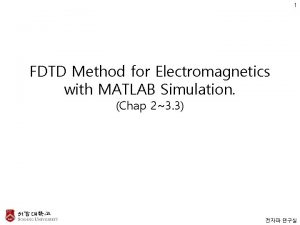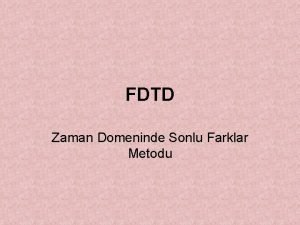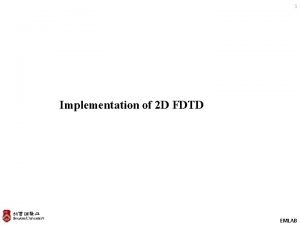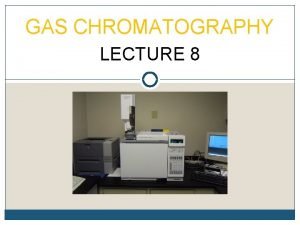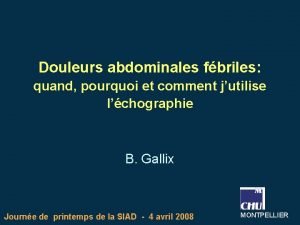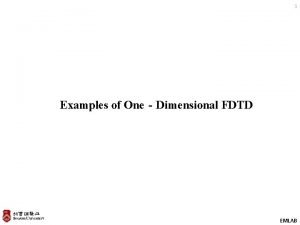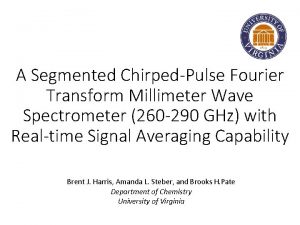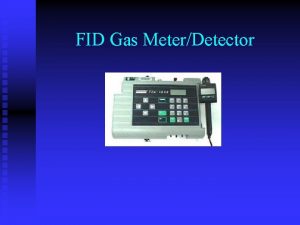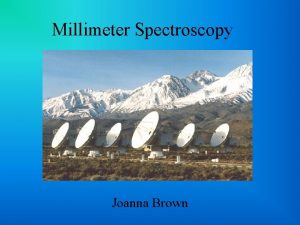FDTD Modeling of FID Signal in ChirpedPulse Millimeter












- Slides: 12

FDTD Modeling of FID Signal in Chirped-Pulse Millimeter Wave Spectroscopy Alexander Heifetz 1, Sasan Bakhtiari 1, Hual-Teh Chien 1, Stephen Gray 1, Kirill Prozument 1, and Richard M. Williams 2 1 Argonne National Laboratory 2 Pacific Northwest National Laboratory 71 st International Symposium on Molecular Spectroscopy

Outline § Motivation – Developing room temperature chemical sensor of trace gases using chirped-pulse millimeter wave (CPMMW) technique – Exploring strategies to improve sensitivity of free induction decay (FID) signal § Approach – Developed computational electrodynamics model of CPMMW using finite-difference time-domain (FDTD) method – Wrote 1 -D MATLAB code and performed preliminary computer simulations on a small grid – Studied electromagnetic power flow in gas cell § Preliminary conclusions – FID emission collinear with incident pulse Nuclear Engineering Division, Argonne National Laboratory 2

Gas Sensing Using CPMMW Rotational Spectroscopy § Principles – CPMMW technique based on measuring free induction decay (FID) signal following passage of broadband pulse § Advantages – High specificity because of narrow linewidth at low pressure and room temperature – Enables background-free measurement • FID and incident pulse time-resolved • FID signal can be amplified with LNA independently of incident pulse • Zero-mean noise removed by averaging § Challenges – Sensitivity of CPMMW should be improved Argonne National Laboratory 3

Motivation for Computational Electrodynamics Model Development § § Develop computational platform for signal sensitivity analysis Specific questions in this study – Detection efficiency of FID measurement in forward direction • Collect all emitted electromagnetic signals? – Spatially resolve FID and incident pulse • Detect FID in backscattering configuration? Conventional Transmission Geometry Design Hypothetical Backscattering Geometry Design Nuclear Engineering Division, Argonne National Laboatory 4

Computational Electrodynamics Approach § Electromagnetic fields in gas cell modeled by solving Maxwell’s equations in 1 -D grid using finite-difference time domain (FDTD) method § Model interaction of molecules with electromagnetic field using density matrix (DM) formulation for two-level system – Enters Maxwell’s equations through induced polarization term |b> |a> § Concurrently solve Maxwell’s equations with auxiliary DM equations Argonne National Laboratory 5

Comparison to Past Work Previous Work § § Model entire molecular ensemble in gas cell with one two level system No electromagnetic field phase information Our Approach § § |b> Model gas cell as collection of independent two-level systems Introduce electromagnetic field phase information |b> |b> |a> |a> |a> § § Analytical solution: J. C. Mc. Gurk, T. G. Schmalz, and W. H. Flygare, “Fast passage in rotational spectroscopy: Theory and experiment, ” J. Chem. Phys. 60 (11), 4181 (1974). Numerical FDTD solution: R. W. Ziolkowski, J. M. Arnold, D. M. Gogny, “Ultrafast pulse interaction with two-level atoms, ” Phys. Rev. A 52(4), 3082 (1995). § Δx Δx i § Δx i+1 Δx i+2 x Equivalent to line of resonant dipoles Argonne National Laboratory 6

Numerical Implementation § § Wrote 1 -D FDTD code in MATLAB Each two-level system at every grid point solved independently by calling MATLAB ODE 45 routine Δx Δx i+1 Δx i+2 § Discretization in space and time related as Δx=cΔt § Performed numerical simulations on small grid x – Grid consists of approximately 100 points ( 1. 5 cm physical length) – Open boundary conditions Nuclear Engineering Division, Argonne National Laboatory 7

Preliminary FDD Simulation Results § Incident linearly frequency-chirped pulse – 100 ns duration, – 4 GHz bandwidth Time domain Frequency domain. Argonne National Laboratory 8

Preliminary FDTD Simulation Results § Calculated FID pulse – Molecular resonant absorption/emission frequency of 50 GHz Time domain Frequency domain. Argonne National Laboratory 9

Preliminary FDTD Simulation Results § Electromagnetic field phasors inside the gas cell § Electric field increases linearly inside gas cell – Oscillations could be physical (standing waves) or unphysical (numerical errors) - TBD § § All FID signal power flows in forward direction Consistent with observation of no back-propagating FID signal in experiments Argonne National Laboratory 10

Analytical Explanation of FDTD Simulations § Consider constructive/destructive interference of signals due to each resonant dipole Δx Δx i § § Δx i+1 Δx i+2 x In 1 -D, each dipole radiates isotopically in +x (φ+=ωt – kx) and –x (φ-=ωt + kx) directions Example: FID signals due to dipoles i and i+1 – In +x direction, Δφ =0, phase of each dipole is the same as the phase of the excitation pulse – In –x direction, Δφ=ωΔt Nuclear Engineering Division, Argonne National Laboatory 11

Conclusion § § § Developed computational electrodynamics model of CPMMW using FDTD method Wrote 1 -D MATLAB code and performed computer simulations on a small grid Results indicate all FID signal power flow is in forward direction Consistent with observation of no back-propagating FID signal in experiments Strategies for numerical optimization to expedite calculations and model larger geometries under investigation Argonne National Laboratory 12
